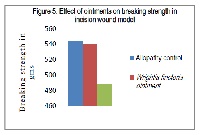Evaluation of herbal ointment formulated with Wrightia tinctoria (ROXB) R. BR. leaves for efficacy of wound healing.
Keywords:
Wound healing, Excision model, Incision model, Ointment, Wrightia tinctoria (Roxb.) R. BrAbstract
The objective in wound management is to heal the wound in the shortest time possible, without infection and fast wound closure. This investigation is to check the rationale behind the traditional use of leaves of Wrightia tinctoria by evaluating the wound healing property of formulated ointment containing Wrightia tinctoria which may facilitate in vivo quantification of skin curative property of the ointment. Controlled wound healing efficacy studies were done on Guinea pig model with incision and excision wounds. Suitable ointment base was selected by Preformulation studies. The ointment was prepared by melt pour and mixing technique with incorporation of Wrightia tinctoria extract in coconut oil. The wound healing effects of the formulations were compared to that of 0.2% w/w nitrofurazone ointment. A better healing pattern with complete wound closure was observed with the treated groups in contrast to the control group. The total epithelization period was 14 days (allopathic control and Wrightia tinctoria ointment) with 19 days for ointment base. The wound contraction to 50% took 6.3 days (allopathic control), 6.5 days (Wrightia tinctoria ointment), against 12.7 days for ointment base. The tensile strength of the test was almost the same as standard ointment. Increased wound breaking strength indicates increase in collagen strength and obviously facilitating wound healing, thus proving that Wrightia tinctoria ointment could be used for wound healing as a safe alternative to synthetic drug ointments.
References
Grove GL, Exfoliative cytological procedures as a nonintrusive method for dermatological studies. Journal of Investigative Dermatology. 1979; (73): 67-69.
Esimone CO, Ibezim EC and Chah KF, The wound healing effect of herbal ointments formulated with Napoleona imperialis. Journal of Pharmaceutical and Allied Sciences. 2000; 1 (3): 294 -299.
Krishnaveni B, Neeharika V, Venkatesh S, Padmavathy R and Madhava Reddy B, Wound healing activity of Carallia brachiata bark. Indian journal of pharmaceutical science. 2000; 71 (95): 576-578.
Lee KH, Studies on the mechanism of action of salicylate retardation of wound healing by aspirin. Journal of pharmaceutical science 1968; 57: 1042.
Mackenzie IC, Ordered structure of the epidermis. Journal of Investigative Dermatology. 1975; (65): 45-51.
Spearman RIC, The comparative biology of collagenous tissue. In: Jarett A, edition, The physiology and pathophysiology of the skin. London: Academic Press, 1974; PP: 896-899.
Winkelmannm RK, Scheen SR, Pyka RA and Coventry MB, Cutaneous vascular pattern in studies with injection preparation and alkaline phosphatase reaction. In: Montagna, W, RA Ellis, eds, Blood vessels and circulation. London: Pergamon press, 1961; PP: 15-18.
Elias PM, Fritsch P, Lampe MA, Williams ML, Brown BE, Nemanic MK and Grayson S, Retinoid effects on epidermal structure, differentiation, and permeability. Laboratory Investigation, 1981; (44): 531-40.
Brantley SK, Davidson SF and Das SK, A dose-related curve of wound tensile strength following ultraviolet irradiation in the hairless guinea pig, The American Journal of the Medical Science, 1991; (302):75-81.
Andrew Chevallier Fnimh, Encyclopedia of Medicinal Plant, published by Dorling Kindersely in Great Britain, 1996; 14-15.



